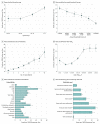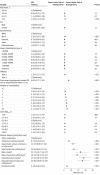Association of Cumulative Multimorbidity, Glycemic Control, and Medication Use With Hypoglycemia-Related Emergency Department Visits and Hospitalizations Among Adults With Diabetes
- PMID: 31922562
- PMCID: PMC6991264
- DOI: 10.1001/jamanetworkopen.2019.19099
Association of Cumulative Multimorbidity, Glycemic Control, and Medication Use With Hypoglycemia-Related Emergency Department Visits and Hospitalizations Among Adults With Diabetes
Abstract
Importance: Severe hypoglycemia is a serious and potentially preventable complication of diabetes, with some of the most severe episodes requiring emergency department (ED) care or hospitalization. A variety of health conditions increase the risk of hypoglycemia. People with diabetes often have multiple comorbidities, and the association of such multimorbidity with hypoglycemia risk in the context of other risk factors is uncertain.
Objective: To examine the associations of age, cumulative multimorbidity, glycated hemoglobin (HbA1c) level, and use of glucose level-lowering medication with hypoglycemia-related ED visits and hospitalizations.
Design, setting, and participants: Cohort study of claims and laboratory data from OptumLabs Data Warehouse, an administrative claims database of commercially insured and Medicare Advantage beneficiaries in the United States. Participants were adults (aged ≥18 years) with diabetes who had an available HbA1c level result in 2015. Data from January 1, 2014, to December 31, 2016, were analyzed. Final analyses were conducted from December 2017 to September 2018.
Main outcomes and measures: This study calculated rates of hypoglycemia-related ED visits and hospitalizations during the year after the index HbA1c level was obtained, stratified by patient demographic characteristics, diabetes type, comorbidities (from 16 guideline-specified high-risk conditions), index HbA1c level, and glucose level-lowering medication use. The association of each variable with hypoglycemia-related ED and hospital care was examined using multivariable Poisson regression analysis overall and by diabetes type.
Results: The study cohort was composed of 201 705 adults with diabetes (mean [SD] age, 65.8 [12.1] years; 102 668 [50.9%] women; 118 804 [58.9%] white; mean [SD] index HbA1c level, 7.2% [1.5%]). Overall, there were 9.06 (95% CI, 8.64-9.47) hypoglycemia-related ED visits and hospitalizations per 1000 persons per year. The risk of hypoglycemia-related ED visits and hospitalizations was increased by age 75 years or older (incidence rate ratio [IRR], 1.56 [95% CI, 1.23-2.02] vs 18-44 years), black race/ethnicity (IRR, 1.30 [95% CI, 1.16-1.46] vs white race/ethnicity), lower annual household income (IRR, 0.63 [95% CI, 0.53-0.74] for ≥$100 000 vs <$40 000), number of comorbidities (increasing from IRR of 1.66 [95% CI, 1.42-1.95] in the presence of 2 comorbidities to IRR of 4.12 [95% CI, 3.07-5.51] with ≥8 comorbidities compared with ≤1), prior hypoglycemia-related ED visit or hospitalization (IRR, 6.60 [95% CI, 5.77-7.56]), and glucose level-lowering treatment regimen (IRR, 6.73 [95% CI, 4.93-9.22] for sulfonylurea; 12.53 [95% CI, 8.90-17.64] for basal insulin; and 27.65 [95% CI, 20.32-37.63] for basal plus bolus insulin compared with other medications). Independent of these factors, having type 1 diabetes was associated with a 34% increase in the risk of hypoglycemia-related ED visits or hospitalizations (IRR, 1.34 [95% CI, 1.15-1.55]). The index HbA1c level was associated with hypoglycemia-related ED visits and hospitalizations when both low (IRR, 1.45 [95% CI, 1.12-1.87] for HbA1c level ≤5.6% vs 6.5%-6.9%) and high (IRR, 1.24 [95% CI, 1.02-1.50] for HbA1c level ≥10%).
Conclusions and relevance: In this cohort study of adults with diabetes, the risk of an ED visit or hospitalization for hypoglycemia appeared to be highest among patients with type 1 diabetes, multiple comorbidities, prior severe hypoglycemia, and sulfonylurea and/or insulin use. At-risk patients may benefit from individualized treatment regimens to decrease their risk of hypoglycemia.
Conflict of interest statement
Figures


References
Publication types
MeSH terms
Substances
Grants and funding
LinkOut - more resources
Full Text Sources
Medical

